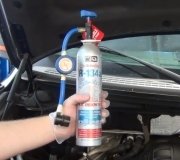Electric motors draw a high current until they get up to speed. That requires a fuse large enough to handle that surge current, and such a big fuse might not protect the wiring properly. Instead, manufacturers often use "fuse link wires" in the wiring harness instead of a plug-in fuse. They act like a "slow-blow" fuse and take a while to burn open. The motor's start-up current drops back to normal long before that wire has a chance to burn open.
I can't remember exactly where your fuse like wires are located, but the place to start looking is on the large stud on the starter solenoid on the inner fender by the battery. The stud you want is the one with the battery cable hooked to the positive post of the battery. The starter solenoid is not part of this circuit. It's just a convenient tie point for a number of other circuits.
Fuse link wires are going to be a different color than the wire they protect because they're only available in a few colors which denote their current rating. They'll be a dull color and rough as opposed to regular wire that has shiny insulation. A fuse link wire's insulation will not burn or melt.
These fuses are typically only a few inches long so you'll be able to see the junctions where they're spliced in. There can be dozens of fuse link wires on older Chrysler products, and they're all in a bundle that goes around the left strut tower. On GMs and Fords, they're just on the end of the wire they protect and are attached just like a regular wire would be. Usually that means with a terminal attached to the end of it and bolted to a stud. I seem to recall a student finding a fuse link on a Tempo near the bulkhead connector next to the power brake booster, but I can't remember which circuit he was working on.
You test a fuse link wire by tugging on it. If it's good, it will act like a wire. If it's burned open, it will act like a rubber band. The wire is a smaller diameter than the wire it protects. If it has burned open in the middle where you can cut it and get to both ends, you can splice them together and seal it with heat-shrink tubing. To function properly you just need a small section that is still the original diameter so it is the weak link in the chain. You can also buy new fuse link wire at any auto parts store. You'll get enough in one piece for two or three repairs. You don't have to use the entire piece.
Now that you have the fan motor running with 12 volts jumped to it, if you DO find the fuse link wire burned open, listen to that motor when you switch it off. You should be able to hear it coast to a stop over a few seconds. If it stops abruptly, the motor is tight and will draw excessive current. In that case replace the motor too to prevent repeat failure of the fuse link wire.
Friday, October 17th, 2014 AT 10:53 PM



